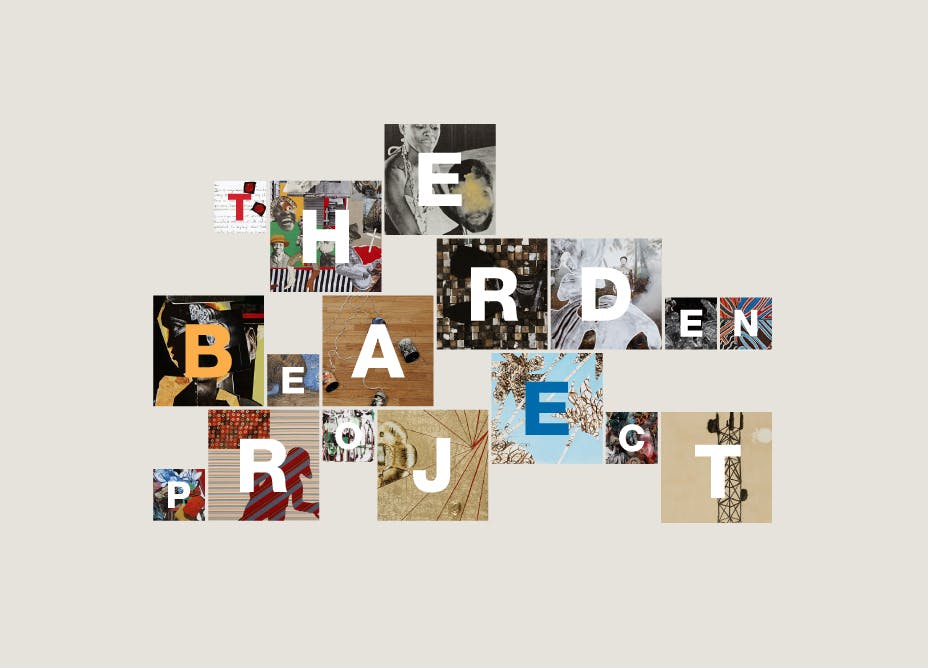Emma Amos
(1937–2020)A painter, printmaker, and weaver, Emma Amos uses color, craft, and canonical imagery to complicate notions of identity—an approach that indicates her lifelong belief in the power of art as a tool for activism.
Biography
Amos grew up in Atlanta, Georgia, where she took up drawing at an early age. People such as W.E.B. Du Bois, Zora Neale Hurston, and Hale Woodruff visited her family home. At the age of sixteen, Amos left Atlanta to attend Antioch College in Ohio; this program allowed her to split her time between academic coursework and professional experiences in London, Chicago, and New York, where she attended myriad gallery and museum exhibitions.
In 1964, while Amos was pursuing a master's degree in art education at New York University, Woodruff invited her to become a member of Spiral, a collective of Black artists including Romare Bearden, Norman Lewis, and Charles Alston. She was the youngest artist and only woman admitted to the group and remained a member until the dissolution of the collective in 1965. Her paintings from the 1960s and 70s depicted scenes of Black middle-class domestic life, and the following decades found her turning to increasingly personal content and experimental practices. She later joined the feminist art groups the Heresies Collective and the Guerrilla Girls. Her signature practice of combining distinctive materials and techniques—which remained central to her work until her passing in 2020—resulted in an intricate investigation into identity, figuration, beauty, and power.
Amos earned her BA from Antioch College and a diploma in etching from the London Central School of Art. Despite her long-standing recognition as an important and frequently exhibited figure in contemporary art, Amos only gained mainstream museum notice in the last few years of her life. In 2017, her work was featured in Soul of a Nation: Art in the Age of Black Power, organized by the Tate Modern, London; and We Wanted a Revolution: Black Radical Women, 1965–85, at the Brooklyn Museum. Her work has been included in Studio Museum exhibitions such as Impressions/Expressions (1979) and The Bearden Project (2012).
Exhibitions and Events
Emma Amos
(1937–2020)A painter, printmaker, and weaver, Emma Amos uses color, craft, and canonical imagery to complicate notions of identity—an approach that indicates her lifelong belief in the power of art as a tool for activism.
Biography
Amos grew up in Atlanta, Georgia, where she took up drawing at an early age. People such as W.E.B. Du Bois, Zora Neale Hurston, and Hale Woodruff visited her family home. At the age of sixteen, Amos left Atlanta to attend Antioch College in Ohio; this program allowed her to split her time between academic coursework and professional experiences in London, Chicago, and New York, where she attended myriad gallery and museum exhibitions.
In 1964, while Amos was pursuing a master's degree in art education at New York University, Woodruff invited her to become a member of Spiral, a collective of Black artists including Romare Bearden, Norman Lewis, and Charles Alston. She was the youngest artist and only woman admitted to the group and remained a member until the dissolution of the collective in 1965. Her paintings from the 1960s and 70s depicted scenes of Black middle-class domestic life, and the following decades found her turning to increasingly personal content and experimental practices. She later joined the feminist art groups the Heresies Collective and the Guerrilla Girls. Her signature practice of combining distinctive materials and techniques—which remained central to her work until her passing in 2020—resulted in an intricate investigation into identity, figuration, beauty, and power.
Amos earned her BA from Antioch College and a diploma in etching from the London Central School of Art. Despite her long-standing recognition as an important and frequently exhibited figure in contemporary art, Amos only gained mainstream museum notice in the last few years of her life. In 2017, her work was featured in Soul of a Nation: Art in the Age of Black Power, organized by the Tate Modern, London; and We Wanted a Revolution: Black Radical Women, 1965–85, at the Brooklyn Museum. Her work has been included in Studio Museum exhibitions such as Impressions/Expressions (1979) and The Bearden Project (2012).
